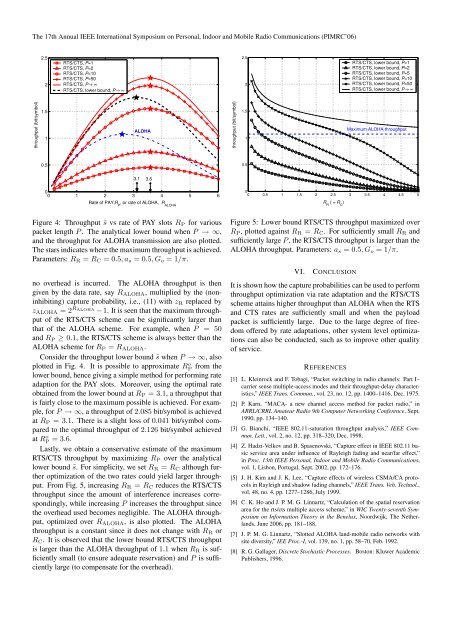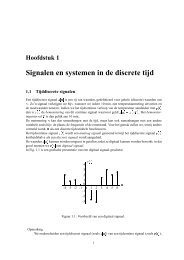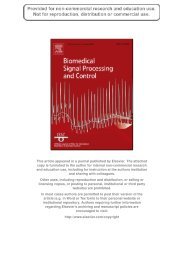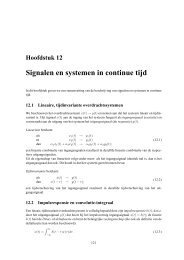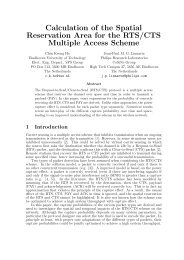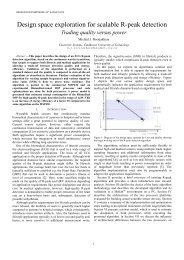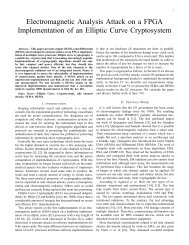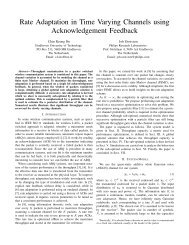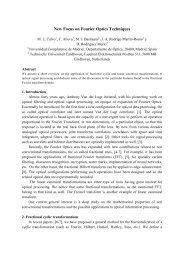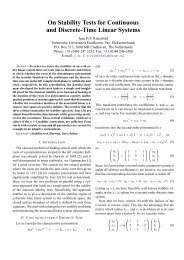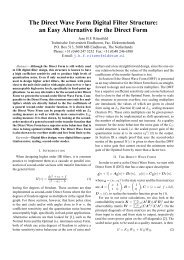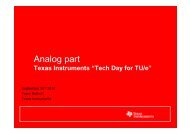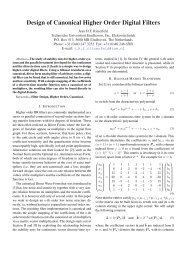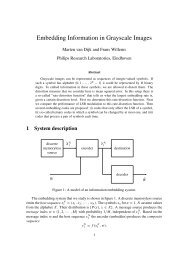analysis of the rts/cts multiple access scheme with capture effect
analysis of the rts/cts multiple access scheme with capture effect
analysis of the rts/cts multiple access scheme with capture effect
You also want an ePaper? Increase the reach of your titles
YUMPU automatically turns print PDFs into web optimized ePapers that Google loves.
The 17th Annual IEEE International Symposium on Personal, Indoor and Mobile Radio Communications (PIMRC’06)<br />
2.5<br />
2<br />
RTS/CTS, P=1<br />
RTS/CTS, P=2<br />
RTS/CTS, P=10<br />
RTS/CTS, P=50<br />
RTS/CTS, P→ ∞<br />
RTS/CTS, lower bound, P→ ∞<br />
2.5<br />
2<br />
RTS/CTS, lower bound, P=1<br />
RTS/CTS, lower bound, P=2<br />
RTS/CTS, lower bound, P=5<br />
RTS/CTS, lower bound, P=10<br />
RTS/CTS, lower bound, P=50<br />
RTS/CTS, lower bound, P→ ∞<br />
throughput (bit/symbol)<br />
1.5<br />
1<br />
ALOHA<br />
throughput (bit/symbol)<br />
1.5<br />
1<br />
Maximum ALOHA throughput<br />
0.5<br />
0.5<br />
3.1<br />
3.6<br />
0<br />
0 1 2 3 4 5 6<br />
Rate <strong>of</strong> PAY, R P<br />
, or rate <strong>of</strong> ALOHA, R ALOHA<br />
0<br />
0 0.5 1 1.5 2 2.5 3 3.5 4 4.5 5<br />
R R<br />
( = R C<br />
)<br />
Figure 4: Throughput ¯s vs rate <strong>of</strong> PAY slots R P for various<br />
packet length P . The analytical lower bound when P → ∞,<br />
and <strong>the</strong> throughput for ALOHA transmission are also plotted.<br />
The stars indicates where <strong>the</strong> maximum throughput is achieved.<br />
Parameters: R R = R C = 0.5, a s = 0.5, G o = 1/π.<br />
no overhead is incurred. The ALOHA throughput is <strong>the</strong>n<br />
given by <strong>the</strong> data rate, say R ALOHA , multiplied by <strong>the</strong> (noninhibiting)<br />
<strong>capture</strong> probability, i.e., (11) <strong>with</strong> z R replaced by<br />
z ALOHA = 2 RALOHA − 1. It is seen that <strong>the</strong> maximum throughput<br />
<strong>of</strong> <strong>the</strong> RTS/CTS <strong>scheme</strong> can be significantly larger than<br />
that <strong>of</strong> <strong>the</strong> ALOHA <strong>scheme</strong>. For example, when P = 50<br />
and R P ≥ 0.1, <strong>the</strong> RTS/CTS <strong>scheme</strong> is always better than <strong>the</strong><br />
ALOHA <strong>scheme</strong> for R P = R ALOHA .<br />
Consider <strong>the</strong> throughput lower bound ˜s when P → ∞, also<br />
plotted in Fig. 4. It is possible to approximate RP o from <strong>the</strong><br />
lower bound, hence giving a simple method for performing rate<br />
adaption for <strong>the</strong> PAY slots. Moreover, using <strong>the</strong> optimal rate<br />
obtained from <strong>the</strong> lower bound at R P = 3.1, a throughput that<br />
is fairly close to <strong>the</strong> maximum possible is achieved. For example,<br />
for P → ∞, a throughput <strong>of</strong> 2.085 bit/symbol is achieved<br />
at R P = 3.1. There is a slight loss <strong>of</strong> 0.041 bit/symbol compared<br />
to <strong>the</strong> optimal throughput <strong>of</strong> 2.126 bit/symbol achieved<br />
at RP o = 3.6.<br />
Lastly, we obtain a conservative estimate <strong>of</strong> <strong>the</strong> maximum<br />
RTS/CTS throughput by maximizing R P over <strong>the</strong> analytical<br />
lower bound ˜s. For simplicity, we set R R = R C although fur<strong>the</strong>r<br />
optimization <strong>of</strong> <strong>the</strong> two rates could yield larger throughput.<br />
From Fig. 5, increasing R R = R C reduces <strong>the</strong> RTS/CTS<br />
throughput since <strong>the</strong> amount <strong>of</strong> interference increases correspondingly,<br />
while increasing P increases <strong>the</strong> throughput since<br />
<strong>the</strong> overhead used becomes negligible. The ALOHA throughput,<br />
optimized over R ALOHA , is also plotted. The ALOHA<br />
throughput is a constant since it does not change <strong>with</strong> R R or<br />
R C . It is observed that <strong>the</strong> lower bound RTS/CTS throughput<br />
is larger than <strong>the</strong> ALOHA throughput <strong>of</strong> 1.1 when R R is sufficiently<br />
small (to ensure adequate reservation) and P is sufficiently<br />
large (to compensate for <strong>the</strong> overhead).<br />
Figure 5: Lower bound RTS/CTS throughput maximized over<br />
R P , plotted against R R = R C . For sufficiently small R R and<br />
sufficiently large P , <strong>the</strong> RTS/CTS throughput is larger than <strong>the</strong><br />
ALOHA throughput. Parameters: a s = 0.5, G o = 1/π.<br />
VI.<br />
CONCLUSION<br />
It is shown how <strong>the</strong> <strong>capture</strong> probabilities can be used to perform<br />
throughput optimization via rate adaptation and <strong>the</strong> RTS/CTS<br />
<strong>scheme</strong> attains higher throughput than ALOHA when <strong>the</strong> RTS<br />
and CTS rates are sufficiently small and when <strong>the</strong> payload<br />
packet is sufficiently large. Due to <strong>the</strong> large degree <strong>of</strong> freedom<br />
<strong>of</strong>fered by rate adaptations, o<strong>the</strong>r system level optimizations<br />
can also be conducted, such as to improve o<strong>the</strong>r quality<br />
<strong>of</strong> service.<br />
REFERENCES<br />
[1] L. Kleinrock and F. Tobagi, “Packet switching in radio channels: Part I–<br />
carrier sense <strong>multiple</strong>-<strong>access</strong> modes and <strong>the</strong>ir throughput-delay characteristics,”<br />
IEEE Trans. Commun., vol. 23, no. 12, pp. 1400–1416, Dec. 1975.<br />
[2] P. Karn, “MACA- a new channel <strong>access</strong> method for packet radio,” in<br />
ARRL/CRRL Amateur Radio 9th Computer Networking Conference, Sept.<br />
1990, pp. 134–140.<br />
[3] G. Bianchi, “IEEE 802.11-saturation throughput <strong>analysis</strong>,” IEEE Commun.<br />
Lett., vol. 2, no. 12, pp. 318–320, Dec. 1998.<br />
[4] Z. Hadzi-Velkov and B. Spasenovski, “Capture <strong>effect</strong> in IEEE 802.11 basic<br />
service area under influence <strong>of</strong> Rayleigh fading and near/far <strong>effect</strong>,”<br />
in Proc. 13th IEEE Personal, Indoor and Mobile Radio Communications,<br />
vol. 1, Lisbon, Portugal, Sept. 2002, pp. 172–176.<br />
[5] J. H. Kim and J. K. Lee, “Capture effe<strong>cts</strong> <strong>of</strong> wireless CSMA/CA protocols<br />
in Rayleigh and shadow fading channels,” IEEE Trans. Veh. Technol.,<br />
vol. 48, no. 4, pp. 1277–1286, July 1999.<br />
[6] C. K. Ho and J. P. M. G. Linnartz, “Calculation <strong>of</strong> <strong>the</strong> spatial reservation<br />
area for <strong>the</strong> <strong>rts</strong>/<strong>cts</strong> <strong>multiple</strong> <strong>access</strong> <strong>scheme</strong>,” in WIC Twenty-seventh Symposium<br />
on Information Theory in <strong>the</strong> Benelux, Noordwijk, The Ne<strong>the</strong>rlands,<br />
June 2006, pp. 181–188.<br />
[7] J. P. M. G. Linnartz, “Slotted ALOHA land-mobile radio networks <strong>with</strong><br />
site diversity,” IEE Proc.-I, vol. 139, no. 1, pp. 58–70, Feb. 1992.<br />
[8] R. G. Gallager, Discrete Stochastic Processes. Boston: Kluwer Academic<br />
Publishers, 1996.


